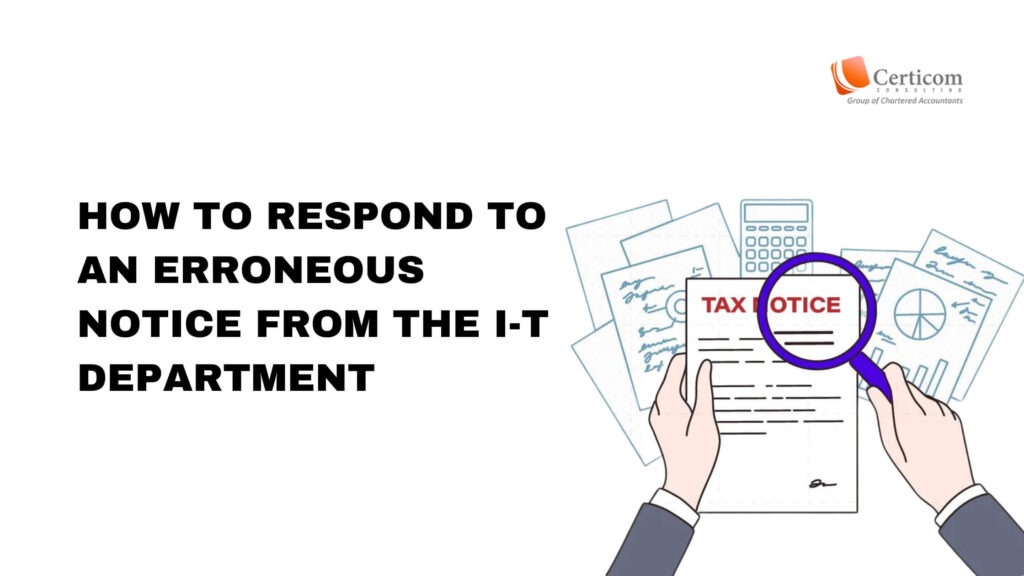How to respond to an erroneous notice from the I-T Department

Several high-net-worth individuals (HNIs) and salaried tax-payers, among others, are in a tizzy after having received notices from the income-tax (I-T) department recently.
Reportedly, the tax authorities have sent out 22,000 notices seeking explanations for discrepancies between Form-16, Form 26AS, Annual Information Statement (AIS), and their returns filed for the financial year 2022-23.
Deductions under section 80C, 80G in focus
Quite often, salaried tax-payers forget to – or are unable to – submit proof of investments made to claim deductions under section 80C, to their employers before the deadline. As a result, their employers deduct excess tax, but employees can claim a refund of this amount at the time of filing their income tax returns (ITR). Since the deductions do not reflect in Form-16, it is bound to differ from actual returns. This could be flagged off as a discrepancy by the I-T department’s scrutiny mechanisms.
“The issue at hand revolves around discrepancies in deductions claimed, such as those related to Section 80C, 80D and 80U, in comparison to what’s reported in their Form 16. These notices pertain to tax returns for the FY 2022-23 (assessment year 2023-24). In essence, taxpayers are being questioned if they’ve claimed higher deductions under Chapter VI-A than what’s reported by their employers in Forms-16.”
Likewise, if the I-T department feels you have claimed deductions under section 80G on donations that seem suspicious, you would have received notices to furnish proof. “Those who have claimed exemptions/deductions on house rent allowance (HRA), and housing loan interest deductions, but have not mentioned it in their Forms-16, have also received notices.”

Discrepancies in foreign asset declaration
If you maintain foreign bank accounts or own stocks or properties abroad, you need to declare the assets in schedule FA (foreign assets) while filing your returns. The catch here is that you are required to disclose assets held during the previous calendar year. That is, if you are filing income tax returns for the financial year 2022-23, you will have to furnish details of foreign assets held between January to December 2022.
How to respond to notices
In many cases, the notices would have been sent based on artificial intelligence-based (AI) algorithms that the tax department uses. “Some are clearly erroneous. In some cases that we have come across, deductions are completely legitimate, yet taxpayers have received notices citing discrepancies. If you fall in this category, ensure that you send your response through the e-filing portal. Explain your position and make it clear that the discrepancies mentioned in the notices are factually misconceived and the ITR details, in fact, are accurate.”
The key is to remain calm and frame a response justifying the deductions claimed if you believe the notice is unwarranted. “Visit the official I-T portal. Look for the specific notice that you received, as it should be available there. Within the notice, you should find an option to respond or submit your explanations along with any supporting documents.”
In case of any doubts, reach out to your chartered accountant to draft an appropriate response. “If your notice is related to a refund claim, and it has been flagged by the I-T department’s risk management process, you can choose the option that states, ‘The claim of refund is correct to the best of my knowledge and belief’.”
Despite providing carefully framed responses and submitting the necessary proof to justify deductions and other claims, the I-T department often sticks to its stand. In such cases, the only option is to go in for an appeal, which is bound to be time-consuming.
“Automation and standardization in scrutinizing tax returns is welcome. However, in some cases, deeper scrutiny and manual intervention is required. AI needs to be more intelligent and machine learning tools need to learn for better results and fewer hassles to honest tax-payers.”

Fraudulent claims bound to face the music
Finally, do not give in to the temptation to claim deductions that you are not eligible for under the mistaken assumption that you won’t face scrutiny. The tax department is employing AI and machine learning tools to flag discrepancies and you could land yourself in a soup in an attempt to make quick savings.
Read More: TAX AUDIT UNDER INCOME TAX ACT,1961
You could end up having to pay penalties if you have erred. “Taxpayers will have to revise their ITR and pay the tax on extra income reported in the ITR. If the tax department finds any problems or differences in the documents provided by these taxpayers in the future, they have the authority to impose a penalty. This penalty could be up to 200 percent of the amount of tax the person should have paid based on their actual income.”
Related Post
Flipkart ESOP Compensation: ₹11 Crore Payout – Salary or Capital Receipt?
Form 16: Key to Accurate ITR Filing
Book A One To One Consultation Now For FREE
How can we help? *




